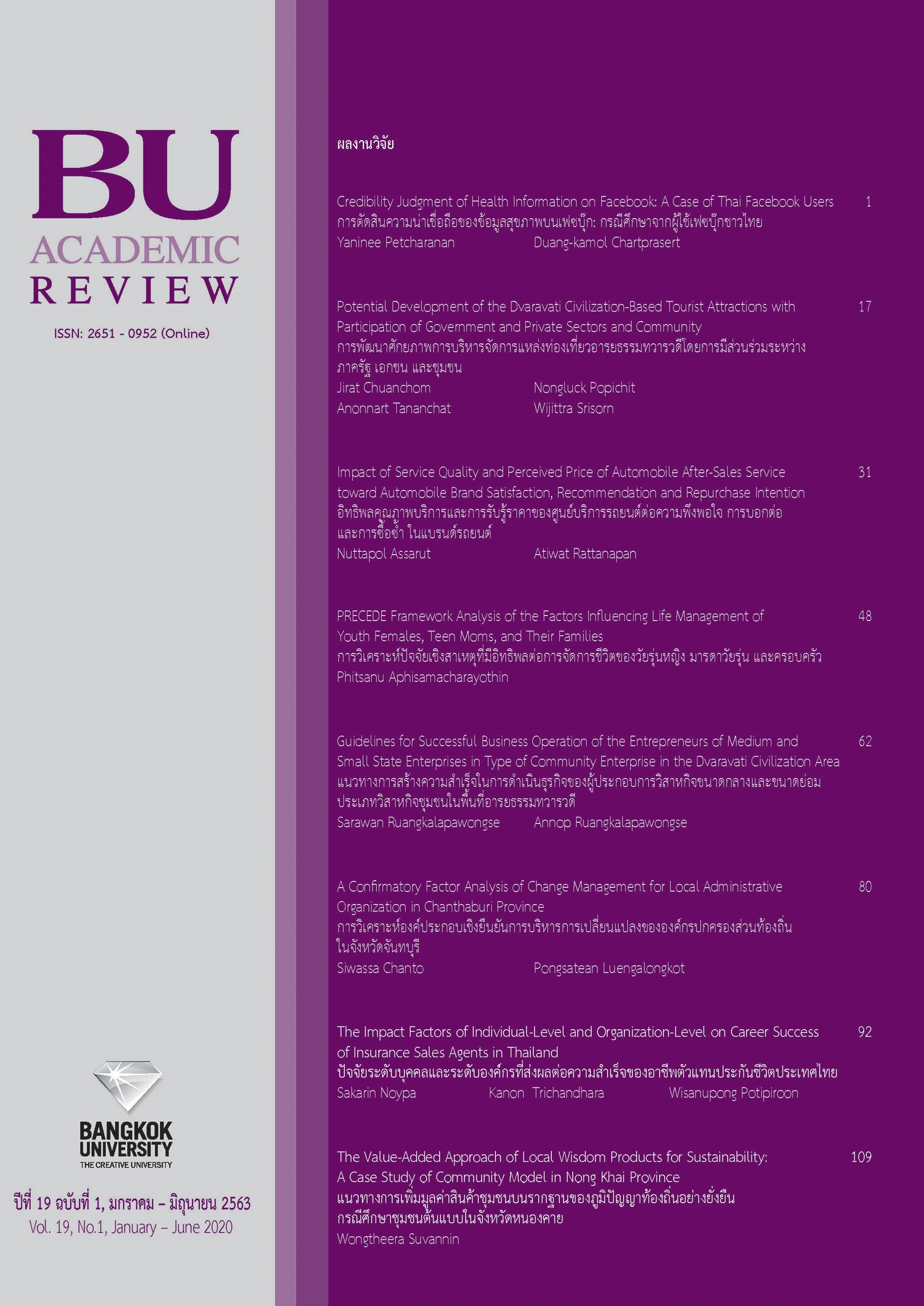Potential Development of the Dvaravati Civilization-Based Tourist Attractions with Participation of Government and Private Sectors and Community
Main Article Content
Abstract
The objective of this research is to study the potential of the Dvaravati Civilization-based tourist attraction management and seek approaches to potentially develop the Dvaravati Civilization-based tourist attractions with participation of government, private sectors and community. The researcher conducted a random survey on 18,361,221 tourists who visited the Dvaravati Civilization-based tourist attractions. The sample group consisted of 400 Thai tourists ageing 20-60 years. Statistical tools used in the data analysis included percentage, mean and standard deviation Cronbach's Alpha was used to assess the reliability of the questionnaire and that is 0.969. Multiple regression analysis was also used to test the correlation among the Variables.
The findings were that the overall opinions of tourists toward the potential of the Dvaravati Civilization-based tourist attractions were at a high level in all aspects. For each aspect, It was found that access to the tourist attractions was ranked first, followed by environment and landscape of those attractions, whereas the security of the attractions was ranked the lowest. As for the relationship with the Dvaravati Civilization-based tourist attraction management, It was found that the relationship was at a high level of 0.707, and the factors of the management of Dvaravati civilization-based tourist attractions affect the potential of Dvaravati civilization-based tourist attraction with a 0.05 level of significance level. As a result, the prediction of the Dvaravati civilization-based tourist attractions management was presented in the Equation: = 1.363 + (0.168Cka) + (0.110Cca) + (0.117Per) + (0.282Sem).
Article Details
The manuscript submitted for publication must be the original version, submitted only to this particular journal with no prior acceptance for publication elsewhere in other academic journals. The manuscript must also not violate the copyright issue by means of plagiarism.
References
APEC International Centre for Sustainable Tourism (AICST). (2006). Tourism risk management – An authoritative guide to managing crises in tourism. Singapore: Asia-Pacific Economic Cooperation (APEC).
Chantaranamchoo, N., Rattanapongpinyo, T., & Ratsasanasart, D. (2014). Development Strategies for cultural tourism relevant to the ASEAN Community based on the creative economy of four Dvaravati Provinces. University of the Thai Chamber of Commerce Journal, 34(4), 1-15.
Dincu, A. (2015). Tourism potential and its role in the development of tourist activity. Scientific Papers: Animal Science and Biotechnologies, 48(2), 183-186.
Kaewmanee, J. (2014). Community-based tourism management in accordance with the philosophy of sufficiency economy of Baan Hua Khao Jean community, Phaktor district, Ratchaburi province. (Master’s thesis, Silpakorn University).
Kasikornbank. (2019). Thailand's Tourism Industry Outlook 2019. Retrieved March 22, 2019 from
https://kasikornbank.com/international-business/en/Thailand/IndustryBusiness/Pages/201901_
Thailand_TourismOutlook19.aspx.
Khunsong, S. (2012). Drawings of Dvaravati people life. Bangkok: Muang Boran Press.
Slehat, M. M. (2018). Evaluation of potential tourism resources for developing different forms of tourism: Case study of Iraq Al-Amir and its surrounding areas – Jordan. (Doctoral Dissertation, Katholischen Universität Eichstätt-Ingolstadt).
Ministry of Tourism and Sports. (2018). Domestic tourist statistics 2018. Retrieved March 22, 2019, from https:// www.mots.go.th/more_news.php?cid=509&filename=index
Naksanee, T. (2012). A project to develop tourism routes: A case study of Dvaravati civilization-Khmer sites in Ratchaburi Province, Thailand. Journal of International and Thai Tourism, 8(2), 1-17.
Office of Permanent Secretary Ministry of Commerce. (2017). Thailand Tourism Statistics Report.
Bangkok: Office of Permanent Secretary Ministry of Commerce.
Jungprawate, P. (2017). Community needs in developing potential for conservation tourism management: A case study of Klong Suan 100 Years old market, Bang Bo district, Samut Prakan province. Journal of Thai Hospitality and Tourism, 12(1), 36-49.
Pender, P., & Sharpley, R. (2005). The management of tourism. London: Sage Publications.
Sonchaem, W., Phuditthanawong, W., Hutacharoen, R., & Hinjiranan, P. (2017). Influential factors on tourism potential of Buddhist temples: Case study of Buddhist temples in cultural conservation zone of Bangkok Metropolitan Administration (Rattanakosin and Thonburi). Kasetsart Journal of Social Sciences, 40(2), 466-471.
Rasoolimanesh, S. M., Ringle, C. M., Jaafar, M., & Ramaya, T. (2017). Urban vs. rural destinations: Residents’ perceptions, community participation and support for tourism development.
Tourism Management, 60(C), 147-158.
Rungmuang, T. (2015). The model development of creative tourism in order to enhance the network of tourism activities of DVARAVATI Four Provinces. Romphruek Journal, 33(1), 138-160.
Segota, T., Kuscer, K., & Mihalic, T. (2016). The impact of residents' informedness and involvement on perceptions of tourism impacts: The case of the destination bled. Journal of Destination Marketing and Management, 6(3), 196-206.
Siribowonphitak, C. (2016). Potential development of cultural heritage tourism of ancient remains in Maha Sarakham. Veridian E-Journal, Silpakorn University, 11(4), 806-816.
Taiminen S. (2018). The negative impacts of overtourism on tourism destination from environmental and socio-cultural perspectives. (Degree Thesis, International Business university of London).
Thongkaew, B., Raksapol, A., Phengkona, J., & Jittapraphan, B. (2017). Potential and guidelines for tourism development in Khanthuli Sub-district, Suratthani province. Area Based Development Research Journal, 9(2), 106-121.
Tourism Authority of Thailand. (2018). PhraPrathonChedi Temple. Retrieved October 25, 2019, from https://www.tourismthailand.org/Attraction/phra-prathon-chedi.
Tourism Western Australia. (2008). Five A’s of Tourism. Retrieved Sep 25, 2018, from https://pgimgmt.com/developing-successful-and-sustainable-tourism-destinations-based-on-the-5-as-of-tourism.
United Nations Environment Programme (UNEP), & World Tourism Organization (WTO). (2005). Making tourism more sustainable: A guide for policy makers. Spain: UNWTO Press and Communications.
Williams, S. (1998). Tourism Geography. London: Routledge.
Yamane, T. (1973). Statistics: An Introductory analysis (3rd ed.). New York: Harper and Row Publication.


